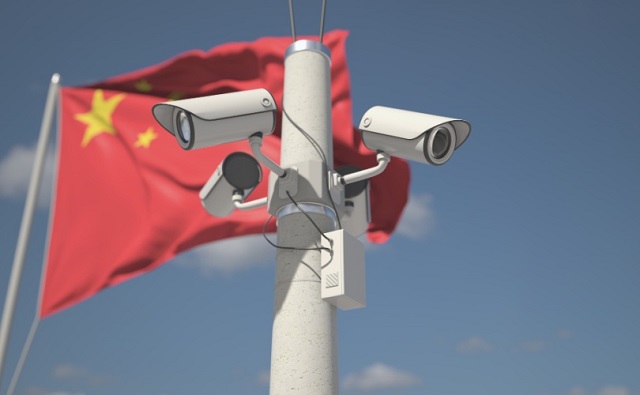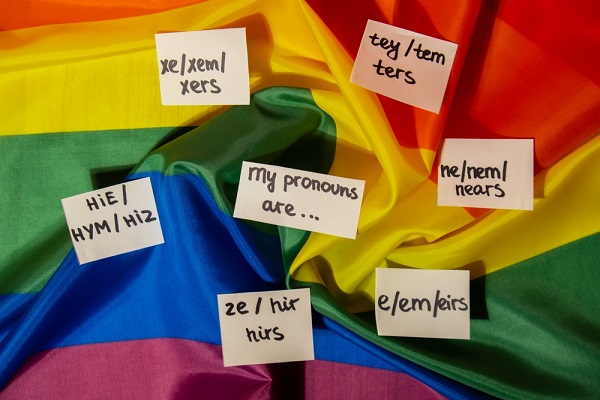Censorship Industrial Complex
Chinese firms show off latest police-state surveillance tech at security expo

From LifeSiteNews
By Angeline Tan
45 Chinese firms have showcased their latest police-state products and technologies, with one expert warning that the communist nation is doing so to normalize their method of surveillance and have it adopted abroad.
45 Chinese firms have showcased their latest police-state products and technologies, including state-of-the-art CCTV, precise DNA-testing technology and intrusive facial tracking software, at the inaugural Public Security Tech Expo in Lianyungang, located in China’s Jiangsu province.
Hosted by China’s First Research Institute of the Ministry of Public Security, the 6-day tech expo which began on September 7 showed off advanced technologies in the domains of “criminal technology, police protective equipment, traffic management equipment, anti-terrorism rescue, and command and communication,” according to the forum’s website.
The website’s official description says “the main purpose of holding the Public Security Tech Expo (Lianyungang) under the framework of the Forum is to deepen technical exchanges and international cooperation in the field of public security science and technology equipment, share useful experience in the application of science and technology equipment to public security practice, and jointly improve the ability and level of maintaining public security.”
One firm participating in the expo, Caltta Technologies, featured a project aimed at “helping” the southern African nation of Mozambique establish an “Incident Response Platform,” extolling its abilities to harness data in “rapid target location.”
Tech giant Huawei was also at the expo, boasting that its “Public Safety Solution” is currently used in more than 100 countries and regions, from Kenya to Saudi Arabia. The United States sanctioned Huawei in 2019, castigating the firm as “an arm” of the Chinese surveillance state.
The expo also saw China’s Ministry of Public Security’s Institute of Forensic Science show off its new high-tech DNA testing technologies. In 2020, Washington banned the institute from accessing some U.S. technology after a number of Chinese firms decried the institute as being “complicit in human rights violations and abuses.”
In 2018, the U.S. Treasury stated that residents of Xinjiang “were required to download a desktop version” of the app “so authorities could monitor for illicit activity.”
Communist China has been slammed for jailing over one million Uyghurs and other Muslim minorities in Xinjiang – claims Beijing vehemently denies. Nonetheless, critics have pointed out how China’s surveillance technologies have been used to draconically suppress dissidents in the Xinjiang province.
During the expo’s opening ceremony, China’s police minister praised Beijing for training thousands of overseas police officers this past year – and pledged to aid in the training of thousands more over the coming year.
Reacting to these disturbing developments, especially China’s activity abroad, Bethany Allen at the Australian Strategic Policy Institute said, “Beijing is hoping to normalize and legitimize its policing style and… the authoritarian political system in which it operates.”
According to UCA News, “China is one of the most surveilled societies on Earth, with millions of CCTV cameras scattered across cities and facial recognition technology widely used in everything from day-to-day law enforcement to political repression.”
The same UCA News article added:
Its police serve a dual purpose: keeping the peace and cracking down on petty crime while also ensuring challenges to the ruling Communist Party are swiftly stamped out.
Notably, various foreign police officers said they hoped to use Chinese surveillance technology to police their own countries.
“We can learn from China,” said Sydney Gabela, a major general in the South African police service, according to UCA News.
“We wanted to check out the new technologies that are coming out so that we can deploy them in South Africa,” Gabela said.
China’s notoriety for being a highly-surveilled state goes back a long way. In 2023, The Economist ran an article detailing how the prevalence of CCTV cameras in Communist China, many bedecked with facial-recognition technology, “leave criminals with nowhere to hide.” A September 2019 report by the U.S. Commission on International Religious Freedom (USCIRF) also disclosed that “the Chinese government has increasingly employed advanced technology to amplify its repression of religious and faith communities.”
The executive summary of the same USCIRF report stated:
Authorities have installed surveillance cameras both outside and inside houses of worship to monitor and identify attendees. The government has deployed facial recognition systems that are purportedly able to distinguish Uighurs and Tibetans from other ethnic groups. Chinese authorities have also collected biometric information—including blood samples, voice recordings, and fingerprints—from religious and faith communities, often without their consent. The government uses advanced computing platforms and artificial intelligence to collate and recognize patterns in the data on religious and faith communities. Chinese technology companies have aided the government’s crackdown on religion and belief by supplying advanced hardware and computing systems to government agencies.
Censorship Industrial Complex
EU’s “Democracy Shield” Centralizes Control Over Online Speech

Presented as a defense of democracy, the plan reads more like the architecture of a managed reality.
|
European authorities have finally unveiled the “European Democracy Shield,” we’ve been warning about for some time, a major initiative that consolidates and broadens existing programs of the European Commission to monitor and restrict digital information flows.
Though branded as a safeguard against “foreign information manipulation and interference (FIMI)” and “disinformation,” the initiative effectively gives EU institutions unprecedented authority over the online public sphere.
At its core, the framework fuses a variety of mechanisms into a single structure, from AI-driven content detection and regulation of social media influencers to a state-endorsed web of “fact-checkers.”
The presentation speaks of defending democracy, yet the design reveals a machinery oriented toward centralized control of speech, identity, and data.
One of the more alarming integrations links the EU’s Digital Identity program with content filtering and labelling systems.
The Commission has announced plans to “explore possible further measures with the Code’s signatories,” including “detection and labelling of AI-generated and manipulated content circulating on social media services” and “voluntary user-verification tools.”
Officials describe the EU Digital Identity (EUDI) Wallet as a means for “secure identification and authentication.”
In real terms, tying verified identity to online activity risks normalizing surveillance and making anonymity in expression a thing of the past.
The Democracy Shield also includes the creation of a “European Centre for Democratic Resilience,” led by Justice Commissioner Michael McGrath.
Framed as a voluntary coordination hub, its mission is “building capacities to withstand foreign information manipulation and interference (FIMI) and disinformation,” involving EU institutions, Member States, and “neighboring countries and like-minded partners.”
The Centre’s “Stakeholder Platform” is to unite “trusted stakeholders such as civil society organizations, researchers and academia, fact-checkers and media providers.”
In practice, this structure ties policymaking, activism, and media oversight into one cooperative network, eroding the boundaries between government power and public discourse.
Financial incentives reinforce the system. A “European Network of Fact-Checkers” will be funded through EU channels, positioned as independent yet operating within the same institutional framework that sets the rules.
The network will coordinate “fact-checking” in every EU language, maintain a central database of verdicts, and introduce “a protection scheme for fact-checkers in the EU against threats and harassment.”
Such an arrangement destroys the line between independent verification and state-aligned narrative enforcement.
The Commission will also fund a “common research support framework,” giving select researchers privileged access to non-public platform data via the
Digital Services Act (DSA) and Political Advertising Regulation.
Officially, this aims to aid academic research, but it could also allow state-linked analysts to map, classify, and suppress online viewpoints deemed undesirable.
Plans extend further into media law. The European Commission intends to revisit the Audiovisual Media Services Directive (AVMSD) to ensure “viewers – particularly younger ones – are adequately protected when they consume audiovisual content online.”
While framed around youth protection, such language opens the door to broad filtering and regulation of online media.
Another initiative seeks to enlist digital personalities through a “voluntary network of influencers to raise awareness about relevant EU rules, including the DSA.” Brussels will “consider the role of influencers” during its upcoming AVMSD review.
Though presented as transparent outreach, the move effectively turns social media figures into de facto promoters of official EU messaging, reshaping public conversation under the guise of awareness.
The Shield also introduces a “Digital Services Act incidents and crisis protocol” between the EU and signatories of the Code of Practice on Disinformation to “facilitate coordination among relevant authorities and ensure swift reactions to large-scale and potentially transnational information operations.”
This could enable coordinated suppression of narratives across borders. Large platforms exceeding 45 million EU users face compliance audits, with penalties reaching 6% of global revenue or even platform bans, making voluntary cooperation more symbolic than real.
A further layer comes with the forthcoming “Blueprint for countering FIMI and disinformation,” offering governments standardized guidance to “anticipate, detect and respond” to perceived information threats. Such protocols risk transforming free expression into a regulated domain managed under preemptive suspicion.
Existing structures are being fortified, too. The European Digital Media Observatory (EDMO), already central to “disinformation” monitoring, will receive expanded authority for election and crisis surveillance. This effectively deepens the fusion of state oversight and online communication control.
Funding through the “Media Resilience Programme” will channel EU resources to preferred outlets, while regulators examine ways to “strengthen the prominence of media services of general interest.”
This includes “impact investments in the news media sector” and efforts to build transnational platforms promoting mainstream narratives. Though described as supporting “independent and local journalism,” the model risks reinforcing state-aligned voices while sidelining dissenting ones.
Education and culture are not exempt. The Commission plans “Guidelines for teachers and educators on tackling disinformation and promoting digital literacy through education and training,” along with new “media literacy” programs and an “independent network for media literacy.”
While such initiatives appear benign, they often operate on the assumption that government-approved information is inherently trustworthy, conditioning future generations to equate official consensus with truth.
Viewed as a whole, the European Democracy Shield represents a major institutional step toward centralized narrative management in the European Union.
Under the language of “protection,” Brussels is constructing a comprehensive apparatus for monitoring and shaping the flow of information.
For a continent that once defined itself through open debate and free thought, this growing web of bureaucratic control signals a troubling shift.
Efforts framed as defense against disinformation now risk becoming tools for suppressing dissent, a paradox that may leave European democracy less free in the name of making it “safe.”
|
|
|
|
You read Reclaim The Net because you believe in something deeper than headlines; you believe in the enduring values of free speech, individual liberty, and the right to privacy.
Every issue we publish is part of a larger fight: preserving the principles that built this country and protecting them from erosion in the digital age.
With your help, we can do more than simply hold the line: we can push back. We can shine a light on censorship, expose growing surveillance overreach, and give a voice to those being silenced.
If you’ve found any value in our work, please consider becoming a supporter.
Your support helps us expand our reach, educate more people, and continue this work.
Please become a supporter today.
Thank you for your support.
|
Censorship Industrial Complex
School Cannot Force Students To Use Preferred Pronouns, US Federal Court Rules


From the Daily Caller News Foundation
“Our system forbids public schools from becoming ‘enclaves of totalitarianism.’”
A federal appeals court in Ohio ruled Thursday that students cannot be forced to use preferred pronouns in school.
Defending Education (DE) filed the suit against Olentangy Local School District (OLSD) in 2023, arguing the district’s anti-harassment policy that requires students to use the “preferred pronouns” of others violates students’ First Amendment rights by “compelling students to affirm beliefs about sex and gender that are contrary to their own deeply held beliefs.” Although a lower court attempted to shoot down the challenge, the appeals court ruled in a 10-7 decision that the school cannot “wield their authority to compel speech or demand silence from citizens who disagree with the regulators’ politically controversial preferred new form of grammar.”
Because the school considers transgender students to be a protected class, students who violated the anti-harassment policy by referring to such students by their biological sex risked punishments such as suspension and expulsion, according to DE.
Dear Readers:
As a nonprofit, we are dependent on the generosity of our readers.
Please consider making a small donation of any amount here.
Thank you!
“American history and tradition uphold the majority’s decision to strike down the school’s pronoun policy,” the court wrote in its opinion. “Over hundreds of years, grammar has developed in America without governmental interference. Consistent with our historical tradition and our cherished First Amendment, the pronoun debate must be won through individual persuasion, not government coercion. Our system forbids public schools from becoming ‘enclaves of totalitarianism.’”
OLSD did not respond to the Daily Caller News Foundation’s request for comment.
“We are deeply gratified by the Sixth Circuit’s intensive analysis not only of our case but the state of student First Amendment rights in the modern era,” Nicole Neily, founder and president of DE, said in a statement. “The court’s decision – and its many concurrences – articulate the importance of free speech, the limits and perils of public schools claiming to act in loco parentis, and the critical role of persuasion – rather than coercion – in America’s public square.”
“Despite its ham-fisted attempt to moot the case, Olentangy School District was sternly reminded by the 6th circuit en banc court that it cannot force students to express a viewpoint on gender identity with which they disagree, nor extend its reach beyond the schoolhouse threshold into matters better suited to an exercise of parental authority,” Sarah Parshall Perry, vice president and legal fellow at DE, said in a statement. “A resounding victory for student speech and parental rights was long overdue for families in the school district and we are thrilled the court’s ruling will benefit others seeking to vindicate their rights in the classroom and beyond.”
-

 Health22 hours ago
Health22 hours agoLack of adequate health care pushing Canadians toward assisted suicide
-

 Business2 days ago
Business2 days agoWill Paramount turn the tide of legacy media and entertainment?
-

 Alberta2 days ago
Alberta2 days agoFederal budget: It’s not easy being green
-

 National14 hours ago
National14 hours agoWatchdog Demands Answers as MP Chris d’Entremont Crosses Floor
-

 Alberta14 hours ago
Alberta14 hours agoATA Collect $72 Million in Dues But Couldn’t Pay Striking Teachers a Dime
-

 Dr John Campbell1 day ago
Dr John Campbell1 day agoCures for Cancer? A new study shows incredible results from cheap generic drug Fenbendazole
-

 Artificial Intelligence22 hours ago
Artificial Intelligence22 hours agoAI Faces Energy Problem With Only One Solution, Oil and Gas
-

 Artificial Intelligence13 hours ago
Artificial Intelligence13 hours agoAI seems fairly impressed by Pierre Poilievre’s ability to communicate










